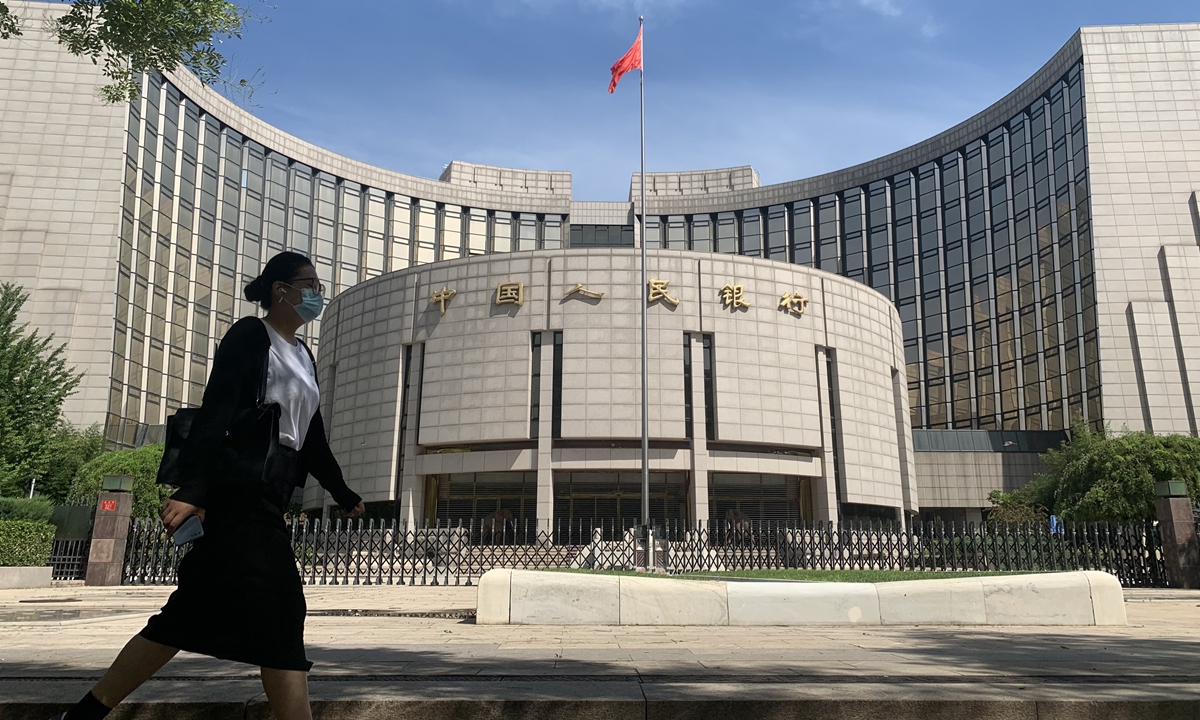
A view of the PBC building in Beijing on August 22, 2022 Photo: VCG
The People's Bank of China (PBC), the central bank, announced on Monday that it's hiking the risk reserve requirement for forward foreign exchange (forex) trading to 20 percent from currently zero, in a fresh move to underpin the yuan's stability amid the US dollar's engulfing strength.
The announcement, emblematic of the PBC's rich policy toolbox to manage currency expectations, is expected to shore up the yuan over the longer term, market observers said, arguing against the Western media hype over crisis-level stress.
The new requirement will take effect on Wednesday, read a concise post on the PBC's website.
It will increase the cost of foreign exchange forward trading by banks and reduce the demand for foreign exchange forward purchases in the market in order to stabilize the yuan, economists said.
On that premise, the market would swing in favor of expectations for a stable yuan, Ming Ming, chief macroeconomist at CITIC Securities, told the Global Times on Monday.
Attributing the yuan's recent depreciation as mostly a mix of US dollar strength and global uncertainties, Ming argued that the yuan isn't under crisis-level stress as suggested by some foreign media reports.
Slides in the yuan and the yen have provided a pretext for some Western media to hype the so-called crumbling of Asian currencies.
Earlier this month, PBC Deputy Governor Liu Guoqiang told reporters that short-term two-way swings would become the norm, but one-way moves aren't likely.
Warning against speculative bets, Liu said that the country has the capacity to support a reasonable, equilibrium-based and basically stable exchange rate.
The yuan's global recognition will continue to rise over the longer term, according to Liu.
In August, the yuan retained its position as the fifth most active currency for worldwide payments in terms of value, with a share of 2.31 percent, per SWIFT's latest monthly yuan tracker. This compared with a share of 2.2 percent in July.
Overall, yuan payments by value gained 9.25 percent compared with July, while all payment currencies rose by 4.01 percent, read the August data.
The PBC's move on Monday sent a strong signal to stabilize both the yuan and market expectations amid recent volatility, Guan Tao, BOC International's global chief economist, told the Global Times on Monday.
It could promote a balance between supply and demand in the foreign exchange market, and avoid excessive "pro-cyclical behavior" and a "herd effect" among enterprises, Guan noted.
The move came amid an increasingly volatile foreign exchange market with the US Dollar Index soaring to a 20-year high, as the US Federal Reserve continues its drastic approach to hiking interest rates in a desperate fight against surging inflation.
The US rate-hiking cycle has battered global financial markets, depreciating non-dollar currencies worldwide and driving capital outflows from many countries and regions, Sun Lijian, director of the Financial Research Center at Fudan University in Shanghai, told the Global Times on Monday.
With the 20-percent risk reserve ratio, Chinese banks will be better-placed to address risks caused by US rate hikes, and this in turn will reduce the potential for systemic risks, Sun noted.
Also on Monday, the PBC vowed to toughen the institutional foundation for the country's sound financial operations and avert systemic risks.
Briefly after the PBC announcement, the offshore yuan strengthened by more than 300 percentage points (pips) versus the US dollar. Throughout Monday, the offshore yuan hovered in a range of 7.10 to 7.17. The offshore yuan closed at 7.1173 during the previous trading day.
The yuan's daily fixing weakened 378 pips to 7.0298 against the US dollar on Monday, official data showed.
The risk reserve requirement is one of the central bank's readily available policy tools in response to currency fluctuations, Ming at CITIC Securities said.
The yuan, albeit subject to passive depreciation pressure in light of the dollar's prolonged strength, will over the longer term return to its fundamental value.
Ming cited revisions to forex reserve requirements for financial institutions, among other options, as part of the PBC's toolbox.
The yuan's moves are also contingent on the recovery pace of China's economic fundamentals, Ming added.
Earlier in September, the PBC announced that it would cut financial institutions' forex requirement ratio by 2 percentage points to 6 percent.
In April, the PBC announced plans to cut the foreign exchange reserve requirements for financial institutions by 1 percentage points to 8 percent amid the yuan's accelerated depreciation at the time.
Prior to the cut that took effect in mid-May, the central bank raised the forex reserve requirement ratio twice last year when the yuan was scrambling to shake off sustained strength.
Similarly, the PBC cut the FX risk reserve ratio to zero from 20 percent in October 2020, when the onshore spot yuan exchange rate hit a 17-month high.




